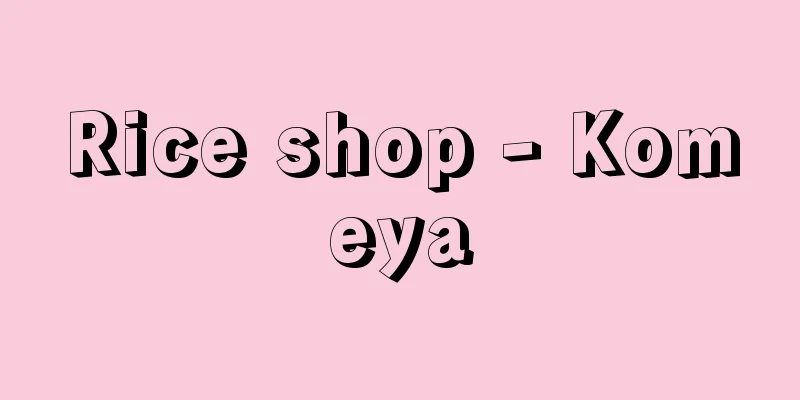Rice shop - Komeya

|
Merchants who buy and sell rice (brown rice and white rice). Their business model is complex. In pre-modern times, rice was paid as tribute, and there were restrictions on its distribution. In ancient public markets between the 8th and 10th centuries, surplus rice was released and sold at rice factories (stores). In the 14th century during the Middle Ages, toimaru (markets) in ports functioned as rice wholesalers, in the 15th century, there were female rice sellers who sold rice by weight at markets in developed regions, and in the 16th century, rice za (rice shop za) was established in Kyoto and monopolized the buying and selling of rice. In the early modern 17th century, rice was bought and sold in large quantities, and a variety of rice merchants appeared. Rice was traded mainly in Osaka and Edo, and there were two types of rice in circulation: stored rice (kuramai) and barn rice (nayamai). Stored rice was rice sold off as annual tax rice (nengumai) by the shogunate and various feudal domains. In Osaka, the various feudal domains had storehouses, and kuramoto (kuramoto) were in charge of buying and selling, while kakeya (kakeya) were responsible for the receipt and disbursement of the payment. Many kakeya were also affiliated with kuramoto (kuramoto) brewers. The sold-off rice was accepted by stored rice wholesalers, and passed on to rice milling stores (tsukigomeya) via rice brokers, rice grain brokers, and cheap rice dealers. In Edo, the Shogunate's stored rice was sold by the Fudasashi (paper dealers), and the rice sold by the various feudal domains was sold by the storehouses and rice exchanges, either through rice brokers or directly to the Wakidana Hachikasho group rice shop, from which the milling shop bought it. Nayamai (rice sold in the storehouse) was sold directly by farmers to rice wholesalers in local cities and towns. Rice collected in the production area was sent to rice wholesalers in the cities. In Osaka, there were nayamai wholesalers, and in Edo, there were shitarimai (rice sold in the storehouses) wholesalers from the Kamigata area, jimawarimai (rice sold in the storehouses) wholesalers from the Kanto and Oshu areas, and in addition, there were Kanto Rice Wholesalers from the nine provinces of Kanto and Mutsu. In Osaka, there were kamitonya (rice sold in the storehouses) and kamizumi (rice sold in the storehouses) wholesalers from the Kyoto area. The rice traded by the wholesalers was unpolished rice, so it had to be polished before it could reach the consumers. The milling shop was a retail rice store that hired rice millers to mill the brown rice purchased from wholesalers in a mortar in front of the store. Many of the rice millers were migrant workers from Kai (Yamanashi Prefecture), Shinano (Nagano Prefecture), and Echigo (Niigata Prefecture) who came to work during the agricultural off-season. In the early modern period, the main distribution centers for large quantities of rice were Osaka, Edo, and port towns such as Sakata, Niigata, Kuwana, Shimonoseki, and Onomichi. In modern times, rice became a commodity. In producing areas, there were rice brokers and export wholesalers who bought rice from farmers, while in consuming areas, there were rice wholesalers who bought rice from producing areas, and rice shops who bought brown rice from them, polished it, and sold it to consumers. Retail rice shops were the previous milling shops. During World War II, state control was strengthened, and the Food Control Law of 1942 (Showa 17) implemented a rice donation system and rationing system, and rice trading was controlled by the Food Bureau. In the modern postwar period, the Food Bureau was reorganized as the Food Distribution Corporation, and rice was distributed from its distribution centers. Although the corporation was abolished in 1951 (Showa 26), the Food Control Law was strengthened in some respects, and the government purchased produced rice at a purchase price and sold it to democratically selected and registered private rice shops, and the retail price (consumer price) was also determined by the government. These rice shops are divided into a few wholesalers and a large number of retailers. However, irregularities in rice distribution by rice shops, the carrying over of large amounts of old rice, and deficits in the Food Agency Accounts (Special Food Control Accounts) led to calls for reform of rice distribution. When the Food Control Law was abolished in 1994 and the Food Law was enacted, rice retailing was greatly relaxed, and supermarkets and other businesses entered the market. In 2004, the Food Law was revised, further relaxing the rules for rice retailers, changing from a registration system to a notification system. As a result, rice shops began to sell products other than rice in addition to polished and white rice. Furthermore, many stores have changed to convenience stores and the number of rice shops that specialize in rice has decreased significantly. Incidentally, because the price of rice was crucial to the lives of ordinary people, rice shops were often the target of attacks during times of economic downturn, such as the uchikowashi attacks in the early modern period and the rice riots of modern times. [Motoo Endo] "A Study of Rice Distribution Systems by Naoji Suzuki (1965, Kashiwa Shobo)" [Reference item] |Rice shop. "Shokunin-zukushi Ekotoba" second scroll (part) The original is by Kuwagata Keisai (Kitao Masami) and the inscription by Kyokaen (Shuzanjin) is owned by the National Diet Library . Rice shop Source: Shogakukan Encyclopedia Nipponica About Encyclopedia Nipponica Information | Legend |
|
米(玄米、白米)を売買する商人。業態は複雑である。米は前近代では貢租であり、流通には制約があった。古代の8~10世紀の公営の市(いち)では余剰米が米廛(こめてん)(店)で放出、販売された。中世の14世紀には港々の問丸(といまる)は米問屋の機能を果たし、15世紀には先進地域の市で米を量り売りする女性の米売りがいたし、16世紀には京都に米座(米屋座)ができて米の売買を独占していた。 近世の17世紀になって、米は大量に売買され、いろいろな米商人が現れた。米の取引は大坂と江戸が中心で、流通米には蔵米(くらまい)と納屋米(なやまい)とがあった。蔵米は幕府、諸藩の年貢米(ねんぐまい)の払下げ米である。大坂には諸藩の蔵屋敷があり、蔵元(くらもと)が売買にあたり、掛屋(かけや)が代金の出納をした。掛屋には蔵元の兼帯が多かった。払下げ米は蔵米問屋が引き受け、米仲買や米穀仲買、駄売屋(だうりや)を通じて搗米屋(つきごめや)に渡った。江戸では幕府の蔵米は札差(ふださし)から、諸藩の払下げ米も蔵屋敷・米会所から、米仲買を通じて、または直接に脇店(わきだな)八ヶ所組米屋に売られ、搗米屋はそこから買った。納屋米は農民が直接に市場に出すもので、地方の市や在町の米問屋へ売った。産地で集荷された米は都市の米問屋に送られた。大坂では納屋米問屋、江戸では上方(かみがた)筋からの下(くだ)り米問屋と、関東・奥州筋からの地回(じまわ)り米穀問屋と、それとは別に関東・陸奥(むつ)9か国からの関東米穀三組問屋があった。なお、大坂には京都筋向きの上(かみ)問屋や上積(かみづみ)問屋があった。問屋で取引される米は玄米であったから、消費者の手に渡るには精米しなければならなかった。搗米屋は小売りの米屋であり、問屋から入手した玄米を米舂(こめつき)を雇って店頭で踏み臼(うす)で精白した。米舂は多く甲斐(かい)(山梨県)、信濃(しなの)(長野県)、越後(えちご)(新潟県)からの農閑期の出稼ぎであった。近世での米の大量集散地は、大坂、江戸のほか、酒田、新潟、桑名(くわな)、下関(しものせき)、尾道(おのみち)などの港町であった。 近代になって、米は完全に商品となった。生産地には生産者の農民から買い集める米仲買と移出問屋、消費地では生産地から買い付ける米問屋と、そこから玄米を仕入れて精白して消費者に小売りする米屋とになった。小売りの米屋は前代の搗米屋である。第二次世界大戦中は国家管理が強化され、1942年(昭和17)の食糧管理法により米穀供出制と配給制が実施され、米取引は食糧営団に統制された。戦後の現代では、食糧営団は食糧配給公団に改組され、その配給所から米の配給を受けた。1951年(昭和26)に公団は廃止されたものの、食糧管理法は一面で強化され、生産された米は政府が買入れ価格で買い入れて、民主的に選ばれて登録した民営の米屋に売り渡し、小売価格(消費者価格)も政府が決定していた。この米屋は少数の卸と多数の小売りに分かれている。しかし、米屋の配給米の不正や古米の大量の持ち越しや食管会計(食糧管理特別会計)の赤字などから、米の流通改革が求められた。1994年(平成6)食糧管理法が廃止となり、食糧法が制定されると、米の小売りは大幅に緩和され、スーパーマーケットなども参入してきた。2004年には食糧法が改正され、米の小売業者は登録制から届出制へと、よりいっそうの緩和がなされている。そのため、米屋も精米や白米の販売のほかに、米以外の商品も取り扱うようになった。さらにコンビニエンス・ストアなどに変更する店も多く、米穀を専門に取扱う米屋は大幅に減少している。 ところで、米価は庶民生活にとって重大なものであったから、米屋は近世の打毀(うちこわし)、近代の米騒動というように不況のときの攻撃の対象となっていた。 [遠藤元男] 『鈴木直二著『米穀配給組織の研究』(1965・柏書房)』 [参照項目] |米屋。『職人尽絵詞』 第2軸(部分) 原図は、鍬形蕙斎(北尾政美)画、杏花園(蜀山人)詞書国立国会図書館所蔵"> 米屋 出典 小学館 日本大百科全書(ニッポニカ)日本大百科全書(ニッポニカ)について 情報 | 凡例 |
<<: Gomel - Gomeri (English spelling) Гомель/Gomel'
>>: Rice Fuku Awa Fuku - Rice Bubble Awa Fuku
Recommend
Stork - Stork
A general term for birds in the family Ciconidae i...
Yahaba [town] - Yahaba
A town in Shiwa County, south of Morioka City, in ...
Giscar d'Estaing, V. (English spelling) GiscardEstaingV
…Fifth Republic [Haruyasu Kato]. . … *Some of the...
La Paz (English spelling)
The de facto capital of Bolivia (the constitutiona...
chapada
...The state capital is Goiânia. Most of the stat...
Santur - Santur (English spelling) Persian
A stringed instrument of the zither family used i...
Cucurbitaceae
...Here we will focus on melons in a broad sense....
Tide - Shio
The periodic rise and fall of sea levels due to th...
Cascade [Mountain Range] - Cascade
A mountain range in the western United States that...
The Adventures of Auggie March
...Both his first novel and his second work, The ...
Honda Motor Co., Ltd. - Honda Motor Co., Ltd.
Honda R&D was founded by Honda Soichiro in 194...
Swinging 60s
...On the other hand, the IRA's struggle for ...
Imo-meji
In tiles, stone masonry, brick masonry, etc., vert...
Pinus sativa (English spelling)
… [Makoto Nishida]. … *Some of the terminology th...
La Rue, P.de (English spelling) LaRuePde
... The generation following Dufay saw the emerge...




![Noto [town] - Noto](/upload/images/67cc7b4c8a095.webp)




